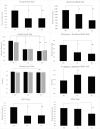Personalized Adaptive Training Improves Performance at a Professional First-Person Shooter Action Videogame
- PMID: 34177682
- PMCID: PMC8224404
- DOI: 10.3389/fpsyg.2021.598410
Personalized Adaptive Training Improves Performance at a Professional First-Person Shooter Action Videogame
Abstract
First-Person Shooter (FPS) game experience can be transferred to untrained cognitive functions such as attention, visual short-term memory, spatial cognition, and decision-making. However, previous studies have been using off-the-shelf FPS games based on predefined gaming settings, therefore it is not known whether such improvement of in game performance and transfer of abilities can be further improved by creating a in-game, adaptive in-game training protocol. To address this question, we compared the impact of a popular FPS-game (Counter-Strike:Global-Offensive-CS:GO) with an ad hoc version of the game based on a personalized, adaptive algorithm modifying the artificial intelligence of opponents as well as the overall game difficulty on the basis of individual gaming performance. Two groups of FPS-naïve healthy young participants were randomly assigned to playing one of the two game versions (11 and 10 participants, respectively) 2 h/day for 3 weeks in a controlled laboratory setting, including daily in-game performance monitoring and extensive cognitive evaluations administered before, immediately after, and 3 months after training. Participants exposed to the adaptive version of the game were found to progress significantly faster in terms of in-game performance, reaching gaming scenarios up to 2.5 times more difficult than the group exposed to standard CS:GO (p < 0.05). A significant increase in cognitive performance was also observed. Personalized FPS gaming can significantly speed-up the learning curve of action videogame-players, with possible future applications for expert-video-gamers and potential relevance for clinical-rehabilitative applications.
Keywords: cognitive training; first-person shooter; human learning; videogame; videogame training.
Copyright © 2021 Neri, Smeralda, Momi, Sprugnoli, Menardi, Ferrone, Rossi, Rossi, Di Lorenzo and Santarnecchi.
Conflict of interest statement
The authors declare that the research was conducted in the absence of any commercial or financial relationships that could be construed as a potential conflict of interest.
Figures




References
-
- Alloway T. (2012). Can interactive working memory training improve learning? J. Interact. Learn. Res. 23 197–207.
LinkOut - more resources
Full Text Sources
Miscellaneous

